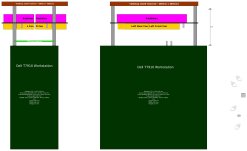WizardOfBoz
Diamond
- Joined
- Sep 30, 2006
- Location
- SE PA, Philly
All,
I have a Dell workstation. A T7910, with dual Xeon processors. Probably about a 6 yo design, but it works. I put pretty spifffy CPUs (E5-2699a - 22 cores each) in the thing and to get something that generates the same benchmarks I'd have to spend about $18000. I run computer models of diseases on the thing. Clinical trials of hundreds of different "virtual patients", spanning trial lengths of years sometimes. For those of a math bent, ODE models with 20-350 state variables, hundres of parameters. CPU intensive: I need the speed.
The Dell design is pretty bombproof, except that since I put in the more powerful CPUs, thermal management is an issue. An extremely poor design choice was made in the design: the CPU coolers (heat pipes with integral fans) blow air parallel to the motherboard. That's not a problem per se, but the exhaust from one CPU goes directly into the intake for the other CPU!. Dell had a solution back in the day: All-In-One (AIO) water-cooled units that blew air away from (perpendicular to) the mobo. To do that I'd need two of those coolers (hard to find, expensive, old and perhaps at end of service life) AND a special cover for my case which is also hard to find and expensive (e.g $116 on ebay). So I could get a questionably reliably system for about $500.
Instead, I bought two large (dual 140mm fan) AIO coolers (Arctic Liquid Freezer II), one unit per each of the two CPUs and will mount them externally. See drawing below.
This brings me to my question. I'm going to have to cut the two tubes for each unit. In the sheathing around one tube runs the wires that power the fans. A 4 conductor flat cable. I'm going to have to put an extension in, and I want to have something that is quick-connect. I had wanted to avoid soldering.
I seem to recall asking this before, but perhaps with less background. I need two connectors. For the quick connect I'm thinking of using a telco RJ-11. Better ideas?
I also need to splice the ribbon connector in at least one place. I was hoping to find a friction connector like one sees in some telco terminal panels. You lay the wires on metal forks in the connector and push down on the cover and the connection is made. Though I can't find any online, so if you know what these are called...

I have a Dell workstation. A T7910, with dual Xeon processors. Probably about a 6 yo design, but it works. I put pretty spifffy CPUs (E5-2699a - 22 cores each) in the thing and to get something that generates the same benchmarks I'd have to spend about $18000. I run computer models of diseases on the thing. Clinical trials of hundreds of different "virtual patients", spanning trial lengths of years sometimes. For those of a math bent, ODE models with 20-350 state variables, hundres of parameters. CPU intensive: I need the speed.
The Dell design is pretty bombproof, except that since I put in the more powerful CPUs, thermal management is an issue. An extremely poor design choice was made in the design: the CPU coolers (heat pipes with integral fans) blow air parallel to the motherboard. That's not a problem per se, but the exhaust from one CPU goes directly into the intake for the other CPU!. Dell had a solution back in the day: All-In-One (AIO) water-cooled units that blew air away from (perpendicular to) the mobo. To do that I'd need two of those coolers (hard to find, expensive, old and perhaps at end of service life) AND a special cover for my case which is also hard to find and expensive (e.g $116 on ebay). So I could get a questionably reliably system for about $500.
Instead, I bought two large (dual 140mm fan) AIO coolers (Arctic Liquid Freezer II), one unit per each of the two CPUs and will mount them externally. See drawing below.
This brings me to my question. I'm going to have to cut the two tubes for each unit. In the sheathing around one tube runs the wires that power the fans. A 4 conductor flat cable. I'm going to have to put an extension in, and I want to have something that is quick-connect. I had wanted to avoid soldering.
I seem to recall asking this before, but perhaps with less background. I need two connectors. For the quick connect I'm thinking of using a telco RJ-11. Better ideas?
I also need to splice the ribbon connector in at least one place. I was hoping to find a friction connector like one sees in some telco terminal panels. You lay the wires on metal forks in the connector and push down on the cover and the connection is made. Though I can't find any online, so if you know what these are called...


